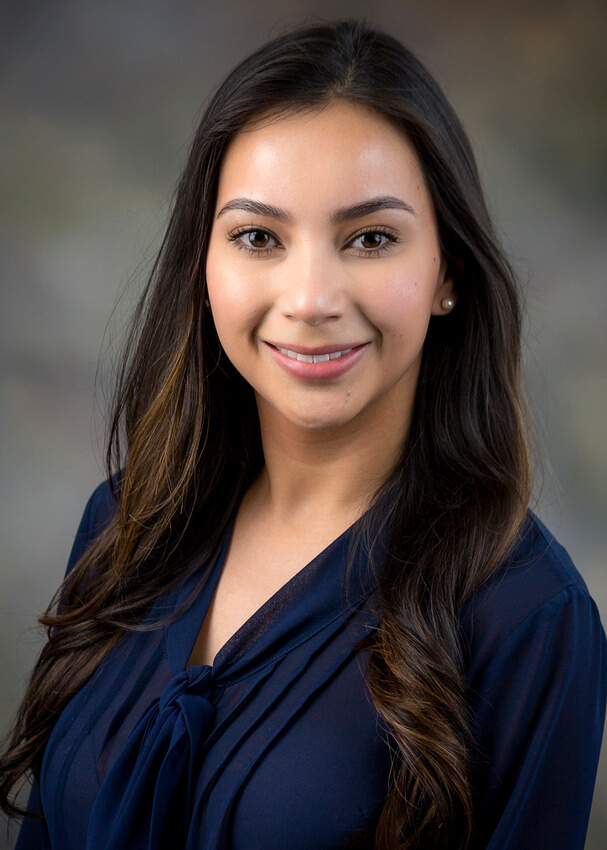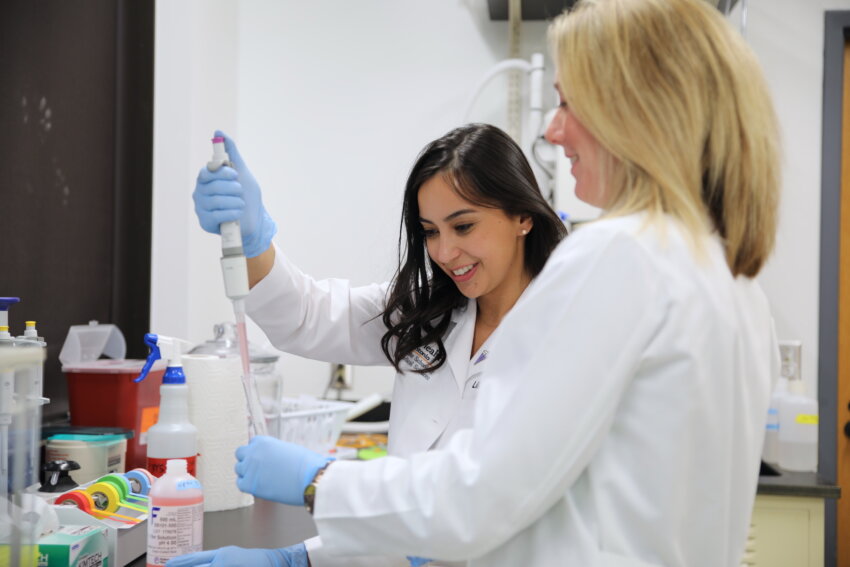Although Lily Espinoza looks forward to her May 21 graduation from the Graduate School of Biomedical Sciences and earning her PhD, she also knows her work will not end there. And not just because there is still research to wrap up, or because she will soon begin her post-doctorate fellowship, but because, for Espinoza, learning is a lifelong pursuit.
Love of learning
 As a first-generation student who moved to the United States from Mexico with her family at a young age, Espinoza’s inquisitive nature was sparked early on, driven to seek answers that her family couldn’t always provide.
As a first-generation student who moved to the United States from Mexico with her family at a young age, Espinoza’s inquisitive nature was sparked early on, driven to seek answers that her family couldn’t always provide.
“Growing up, I always loved learning. I’m the first in family to go to college, finish high school, or even finish grade school,” Espinoza said, “And there were so many things I wanted to know, but my parents couldn’t explain any of those things to me, so I just always loved learning new things in school.”
An early curiosity about how the brain worked, sparked from a high school psychology class, led her to further scientific pursuits in research and medicine. As an undergrad at St. Mary’s University, she spent time shadowing physicians and working as a lab technician. With encouragement from mentors, she applied and was accepted into a competitive research program, spending two consecutive summers at the University of Pittsburgh conducting cardiovascular research.
Connecting the head and the heart
Still yearning to return to her first love, the brain, Espinoza found the perfect home as a student in the Neuroscience discipline of the Integrated Biomedical Sciences PhD Program in the lab of Carie Boychuk, PhD, assistant professor in the Department of Cellular and Integrative Physiology.
“I was always interested in the brain because there are still so many unknowns in that field, but my research has always been in cardiovascular disease,” Espinoza said. “When I got to the university and found Dr. Boychuk, her research married both fields, neuroscience and cardiovascular research, and I feel like that was the best possible fit for me.”
In Dr. Boychuk’s lab, Espinoza studies the parasympathetic innervation of the heart, investigating how the neuronal circuits may contribute to an increased risk for cardiovascular disease. In other words, she studies the connection between the brain and the heart.
“Heart disease is the number-one killer in the U.S. and worldwide, and now there has finally been a shift to look at the brain because we’re realizing that even before someone becomes diabetic or obese, which are risk factors for heart disease, the motor neurons that innervate those systems are not firing properly,” Espinoza said.
Creativity in science
Because Dr. Boychuk’s lab is one of the few in the world to map the neurons that innervate the heart, there exists a lack of tools on the market for the specific research being conducted. To overcome this lack, Espinoza had to create a special, mouse-sized endoscope to help her ventilate mice during procedures that required her to open a mouse’s chest cavity.
“Normally, they would perform a tracheotomy to ventilate a rodent during surgery, but because the mice are so tiny, it was still leading to a lot of deaths in the mice,” she said. “By making our own endoscope we could ventilate them the way we do with humans, by intubating them, without having to do a procedure that leaves a hole in their trachea. And that’s been very successful for us. It was amazing because I love to create things.”
Compassion in medicine
Something else Espinoza hopes to create is a compassionate, accessible environment for her future patients. After her fellowship, Espinoza will also pursue a medical degree.
For Espinoza, one of the biggest draws of the Neuroscience discipline was its clinical component. After her experiences working with patients during the clinical practicum of her second year, she realized how much she loved working with the patients who would ultimately benefit from her research.
“To me one of the biggest motivators when I’m in the lab is to remember who I am trying to help,” Espinoza. “I went for the PhD first because I really love research, but then when I was in the clinic working with patients, I found that I needed that. That’s the motivator for me. So that’s what led me to pursue an MD. And I wouldn’t want to do just one or the other, I really want to do both.”
Beyond that motivation, she is also passionate about breaking down language barriers and other care access barriers for Spanish-speaking patients. Her experiences growing up and frequently translating for her family, as well as her experience translating for physicians at the clinic made it clear to Espinoza just how important translation is in health care, especially in San Antonio.
“Imagine being a patient and maybe only knowing the basics of English and trying to understand all the medical jargon. As I’ve shadowed physicians in the clinic, I’ve seen that face of relief in the Spanish-speaking patients when I start speaking Spanish to them. Sometimes it can be a very scary thing that you’re saying to them [about their condition or diagnosis], but at least you speak their language and they understand what’s going on. To me, it’s very important.”
Next steps
Even though her studies are far from over and there is still much work ahead of her, Espinoza reflects on her time and efforts at the Graduate School of Biomedical Sciences with pride.
“I think it’s helped me grow a lot and I am appreciative of all the time I’ve spent here. I’ve met a lot of scientists and they really care about the students and helping them to develop the skills they need to be successful in the field,” Espinoza said.
“There’s still so much that’s not known, and I wanted to contribute to that. I consider it a privilege that our research is funded and that we get to add to knowledge. It’s very humbling. I’m honored that I get to contribute a little piece to that.”


